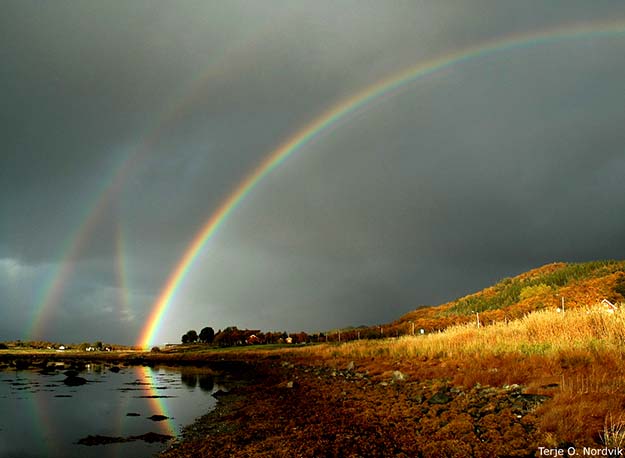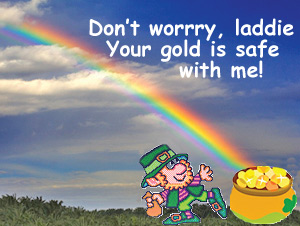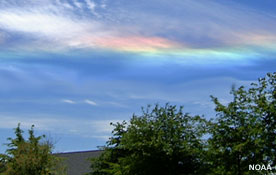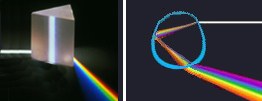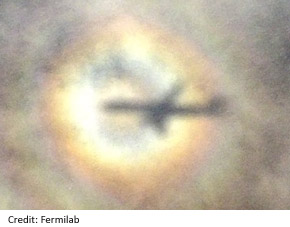Yes, this rainbow can honestly tell this leprechaun that his gold is safely stored at the end of the rainbow. After all, have you ever known anyone who has ever even gotten to the end of rainbow, even with a pot of gold tempting them? Even if a rainbow is right in front of you, it always still seems to stay out of reach. And, the concept of gold being at the rainbow is actually a historical rearrangement of the original concept that your chance of finding the end of a rainbow was about the same as your finding a pot of gold.
Maybe it is best not to try to analyze one of nature’s magical wonders as a rainbow too much (care to vote for your favorite water body?), as even the concept of the rainbow being a bow (arc) is not entirely true. Did you know that if the horizon wasn’t in the way, a rainbow would take the shape of a circle (as seen from an airplane, as in the picture below)?
Sun dogs
Does this picture look familiar? It shows a parhelion, more commonly known as a “sun dog”. Oddly, I have seen these but never knew the official name until researching this article. In fact, sun dogs are a lot more common than rainbows. They are formed by light refracting through the ice crystals of cirriform clouds.
The most common parhelia are seen about 22° on either side of the sun; they are created by falling ice crystals in the Earth’s atmosphere. As water freezes in the atmosphere, small, flat, six-sided, ice crystals might be formed. As these crystals flutter to the ground, much time is spent with their faces flat, parallel to the ground.
Why all the color?
Probably in school you did an experiment where the teacher shines a white light through a glass triangle—a prism, as in the left-side picture. The white light emerges from the prism split up into individual beams of different colors. The colors coming out of the prism, and in the rainbow, too, thus come from light, sunlight in the rainbow’s case. Sunlight is white light, but white light actually contains all of the colors of the rainbow all ready for you to see, but blended together. Light has wavelengths (don’t ask me what this means!) and each color of light has a different wavelength. When the light enters the glass, which is denser than air, it slows down and is bent, with the different wavelengths that make up white light bending at different angles (red on one side to violet on the other).
A similar situation happens in a raindrop, as the right side picture shows. The water drop is acting like a prism, except the light is being refracted at three different points (some of the light bounces off the back of the raindrop and back out to you as you watch). Each time the light beam bounces, it gets wider, and the rainbow you see is a combination of millions of these light beams coming back to you.
♫ Somewhere over the raincircle ♬ …
just doesn’t sound right
In daily life you don’t see rainbows very often, as three things have to come together:
- The sun has to be shining, at least in part of the sky
- There must be water drops or rain falling on the opposite side of the sky from the sun
- You have to be standing with the rain in front of you and the sun behind you
The brightest rainbows appear when the water drops in the sky are large, so if a big rainstorm is moving off in front of you, the rainbows will be more spectacular. The lower the sun is to the horizon the more arc you will see. And, if you could float upwards, the higher you got the more circular the rainbow would become, especially if the sun is directly behind you. Circular rainbows are seen all the time—not by floating people but by passengers flying in airplanes.
Multiple rainbows—a rarity
Have you ever seen six rainbows at once? They are not only rare to see — they are a puzzle to understand. The common rainbow is caused by sunlight internally reflected by the backs of falling raindrops, while also being refracted at the air/water boundary. The sunlight in this picture is coming from behind the observer, and the rainbows are in the rainstorm. The brightest rainbow is the primary rainbow.
Above and to the left of the main rainbow is a secondary rainbow, caused by multiple internal reflections inside water droplets, with colors reversed. Harder to explain is the intermediate rainbow, between the two. This rainbow is likely caused by sunlight that has first reflected off the lake before striking the distant raindrops that is reflecting sunlight back toward the observer. That accounts for the three rainbows in the sky, and the other three are reflections of the rainbows in the sky on the lake’s surface. Kind of cheating to say there are six rainbows, but why argue with such a spectacular show? (NASA).
You’re probably wondering the same thing that I’m wondering—why are the colors of the secondary rainbow reversed? And why is there a secondary rainbow at all? After researching this I still can’t understand it, so here is an explanation from the National Center for Atmospheric Research and the UCAR Office of Programs:
“Sometimes we see two rainbows at once, what causes this? We have followed the path of a ray of sunlight as it enters and is reflected inside the raindrop. But not all of the energy of the ray escapes the raindrop after it is reflected once. A part of the ray is reflected again and travels along inside the drop to emerge from the drop. The rainbow we normally see is called the primary rainbow and is produced by one internal reflection; the secondary rainbow arises from two internal reflections and the rays exit the drop at an angle of 50 degrees° rather than the 42°degrees for the red primary bow. Blue light emerges at an even larger angle of 53 degrees°, this effect produces a secondary rainbow that has its colors reversed compared to the primary.”
Rainbows are rare—so make your own
When my daughter was 10 years old she made us get a dog by saying “Every child should have a dog”. Maybe so; but it is definitely sure that every child should see a rainbow. Children growing up in Lquique, Chile, where it may not rain for years at a time, can still experience rainbows because anyone can make their own. All you have to do is use a garden hose or yard sprinkler. Just set up the yard sprinkler,and stand between it and the sun. The rainbow appearing before you is just as real and natural as the one you see from a rainstorm … and, a lot closer.
Source: http://ga.water.usgs.gov
Dear User/Visitor! Please, answer on our questions: tick off one of the positions – your answer will make us able to improve our site and make it more interesting and useful!

